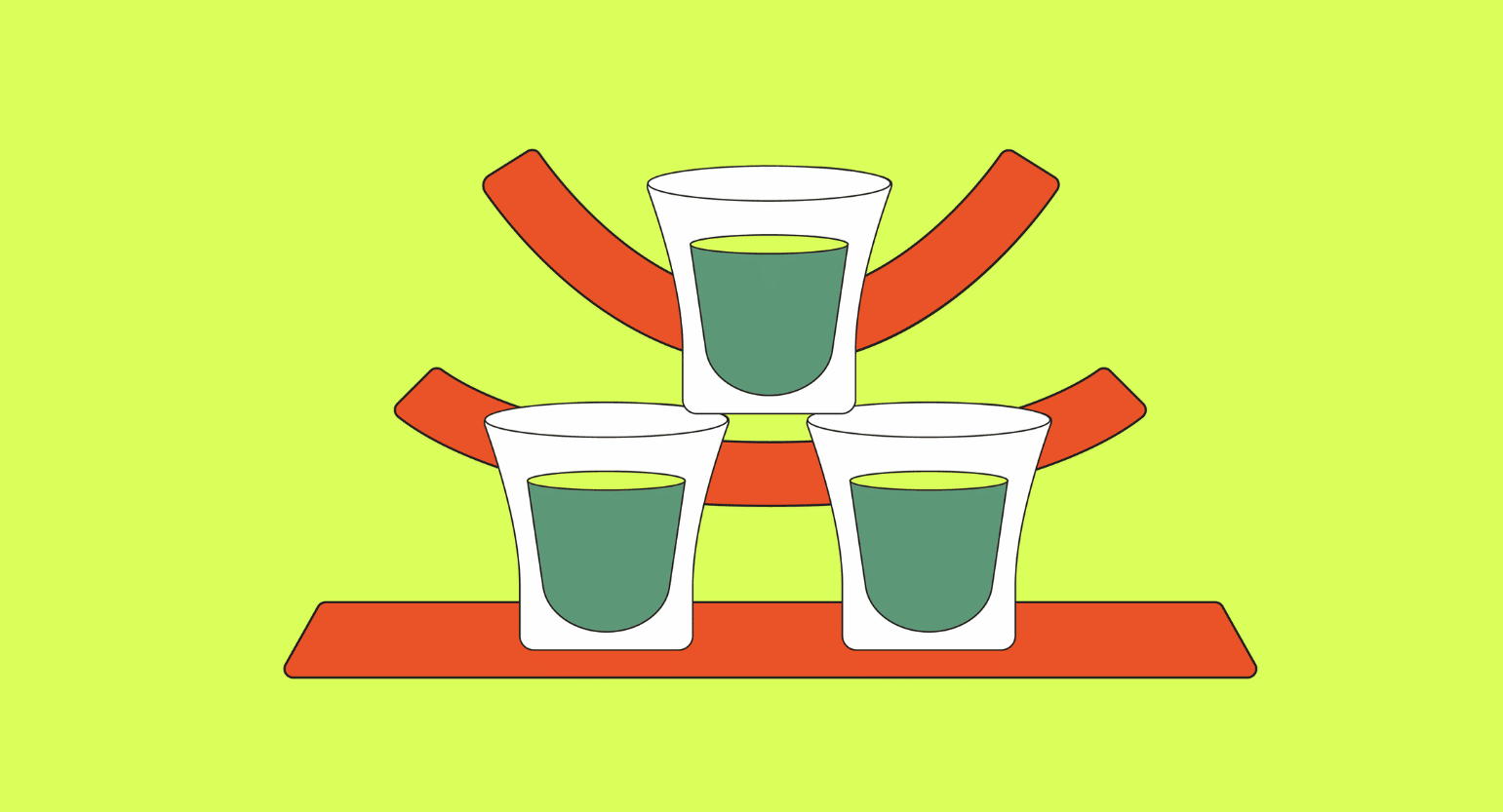There are dozens of different strains to choose from — which can feel intimidating to new users.
Here, we’ll cover all the different kratom strains, organized first by the color of the leaf veins and then by geographical location. By the time you finish this article, you should have a good idea of how to choose the best kratom strains to match your goals.

Kona Kratom
Kratom Strains 101
In total, there are more than 50 different strains of kratom.
Each one is differentiated by its geographical location (Thailand, Bali, Borneo, Indonesia, Sumatra, etc.) and the vein color (red, white, yellow, green).
There are also a few strains named after the region they’re grown in (Hulu, Jong Kong, Kali).
Some strains are named after the unique leaf shape (elephant and horn kratom).
What really makes one strain different from another is the leaves’ chemical composition.
The primary active ingredients in kratom are mitragynine, paynanthine, speciociliatine, and 7-hydroxymitragynine (7-HMG), but there are over a dozen other active alkaloids that contribute to how each strain feels as well.
Every strain has a unique cocktail of these active ingredients. Different chemical ratios can alter the color of the leaf veins and the effects the leaves provide.
What Is a Strain?
While the word species is used to differentiate plants with different genetics, a strain refers to plants that have the same genetic makeup but different growth patterns or chemical composition (called phenotypes).
All kratom is the same species — Mitragyna speciosa — but each plant manufactures a different ratio of the active ingredients.
For a good example of a strain, consider the tomato plant. There are so many different types of tomatoes, some red, some purple, some yellow — but all of them are the same species (Solanum lycopersicum). If you were to look at the genetic code of a beefsteak tomato and a cherry tomato — you’ll find they’re exactly the same. The way these genes are expressed is slightly different.
You can think of the genes like a recipe book for the plant. So in effect, each tomato plant uses the same recipe book but decides to use different recipes to prepare a meal. This is what leads to such a wide variability of the different sizes and shapes of the tomato itself.
Kratom is the same. It shares the same genetic code as any other kratom plant, but each strain expresses the genes differently to produce a completely unique chemical profile.
Kratom Strains by Vein Color
The most common way to organize the different strains is to look at the color of the leaf veins. You can find kratom with bright red, white, or green veins — which gives us a clue as to the effects we’re most likely to feel from that particular strain.
You won’t be able to see the different vein colors when you order your kratom because this part is removed during processing.

Red Vein Kratom Strains
Red vein kratom strains are the most popular among people using the herb to promote sleep or reduce pain. They’re particularly high in the alkaloid 7-hydroxymitragynine, which is one of the primary mu-opioid receptor agonists in the plant.
These strains are fast-acting and powerful — so make sure to start with a smaller dose when using these for the first time.
The strongest kratom currently available for managing pain is the Red Maeng Da strain.
Red Vein Kratom Strains Chart

Green Vein Kratom Strains
Green vein kratom strains are considered more balanced than the other strain types.
Their effects are somewhere in the middle between stimulating and relaxing — but there are exceptions. Some green kratom strains, such as green Bali kratom, are much more stimulating than the rest.
There are no particularly sedating green vein kratom strains.
In general, green vein kratom is considered well-rounded and can be used for both energy and sleep support, depending on the dose. They’re a great option for beginners looking to experience kratom for the first time.
Green Vein Kratom Strains Chart

White Vein Kratom Strains
White vein kratom is the opposite of red vein. They’re only mildly sedative and analgesic — but offer excellent stimulating and euphoric qualities instead. They induce a feeling of clear-headedness and a positive attitude — which makes them excellent options for people using kratom in small doses as a nootropic.
Many people use white vein kratom first thing in the morning in place of coffee or in microdoses to promote focus, concentration, and productive flow states. Red vein kratom is reserved for use in the evening when the stimulating effects of white kratom start to wear off.
The most stimulating white vein kratom is white horn kratom.
White Vein Kratom Strains Chart

Yellow Vein Kratom Strains
Yellow vein kratom is not technically a different strain of kratom like red, white, or green. You won’t find yellow vein kratom in nature.
Instead, yellow vein kratom is made by processing raw white kratom strains in a particular way. This method of drying and processing the leaves changes the color from white to yellow and alters the effect profile of the plant.
Yellow kratom strains are similar to green Malay kratom in terms of effect. They’re potent, euphoric, and have a very clean “pick-me-up” sort of feel to them. They’re also particularly long-lasting. Many people prefer yellow vein varieties to white vein precursors as a nootropic or mood-booster.
Yellow Vein Kratom Strains Chart
| Name | ⚡ Energy | 🌈 Mood | 😮💨 Pain Relief | 💤 Sedation | 😰 Anxiety-Relief |
| Yellow Bali Kratom | |||||
| Yellow Borneo Kratom | |||||
| Yellow Elephant Kratom | |||||
| Yellow Horn Kratom | |||||
| Yellow Indo Kratom | |||||
| Yellow Maeng Da Kratom | |||||
| Yellow Malay Kratom | |||||
| Yellow Sumatra Kratom | |||||
| Yellow Thai Kratom | |||||
| Yellow Vietnam Kratom |
Other Kratom Strains
Beyond the color of the leaf veins, kratom can be broken down into strains named after their origin, the shape of their leaves, or another unique traditional name given to them over the years.
Kratom has been used for centuries, so there are many different strains that have been developed or discovered over time.

Maeng Da Kratom
Maeng da kratom is, by far, the most well-known kratom strain. There are several different types to choose from depending on where it was grown and the color of the leaf veins.
Maeng da was originally from Thailand but is now grown all over Southeast Asia. This strain is made by creating very specific growing environments for the plant that condition it to have the “maeng da characteristics.”
These strains are highly analgesic, sedative, and “heavy” feeling.
List of Maeng Da Kratom Strains:
- Green Maeng Da Kratom
- White Maeng Da Kratom
- Yellow Maeng Da Kratom
- Red Maeng Da Kratom

Bali Kratom
There are many different strains of kratom unique to the island of Bali. Each one has a different set of effects, which comes down to the individual vein color of the leaves.
In general, Bali strains are more relaxing than stimulating.
Even white vein Bali is closer to the middle of the spectrum regarding the plant’s stimulating or euphoric effects.
List of Bali Kratom Strains:
- Red Bali Kratom
- White Bali Kratom
- Yellow Bali Kratom
- Green Bali Kratom

Bentuangie Kratom
Bentuangie kratom is a strain of red vein kratom that’s been fermented during the drying process. Many users consider this variety to be the best for managing pain. It’s particularly useful for mitigating pain that’s described as being “sharp” or “jabbing” and less useful for pain described as “dull” or “throbbing.”

Indo Kratom
Indonesia is made up of thousands of different islands, which has led to an incredible diversity in the region’s flora and fauna. The climate here is perfect for kratom to thrive. As a result of the ideal growing conditions and segregated growing environments, Indonesia has the greatest diversity of kratom strains in the world.
Nearly 95% of the world’s kratom supply comes from Indonesia. Virtually all strains are cultivated in one way or another in Indonesia.
List of Indo Kratom Strains:
- White Indo Kratom
- Red Indo Kratom
- Green Indo Kratom
- Yellow Indo Kratom

Thai Kratom
All three-leaf vein types (red, green, and white) grow naturally throughout Thailand. Some growers in the region also produce yellow vein strains as well.
Thailand produces some of the best kratom in the world — despite having unfriendly laws toward the plant. Locals have used the herb for hundreds of years, and the plant has developed a strong connection with the Thai people.
List of Thai Kratom Strains:
- White Thai Kratom
- Red Thai Kratom
- Green Thai Kratom
- Yellow Thai Kratom

Horn Kratom
Horn kratom is a rare strain only found in Borneo. These strains’ leaves have a characteristic appearance — sporting small spikes (horns) on the leaves.
These strains are usually more expensive than other varieties because of two key factors. They’re elusive (found on only one island), and are particularly difficult to cultivate — requiring very particular growing conditions in order to thrive.
Horn kratom strains tend to be more potent than other strains on the market — producing a higher concentration of both the stimulant and sedative alkaloids.
List of Horn Kratom Strains:
- Red Horn Kratom
- White Horn Kratom
- Green Horn Kratom

Elephant Kratom
Elephant Kratom is named after the shape of its leaves — which resemble elephant ears.
The larger size of these kratom leaves means these plants produce more of the active alkaloids per plant, but they’re particularly difficult to grow. Elephant kratom has a very specific set of environmental conditions required to survive. They need very high yearly rainfall, consistent humidity levels, and dense rainforest cover to grow.
Traditionally, these strains have been associated with the elephant in other ways too. They’re thought to be the best strain choice for improving memory and physical stamina — just like the mighty elephant.
List of Elephant Kratom Strains:
- White Elephant Kratom
- Red Elephant Kratom
- Yellow Elephant Kratom

Hulu Kratom
Hulu kratom refers to strains grown in a particular region of Indonesia — in the Kapuas Hulu region of the Southwest portion of the main island. Most Hulu kratom is grown around the Kapuas River, which is the longest river in the country. The soil near this river is considered sacred and provides some of the most fertile soil on earth.
There are only two types of Hulu kratom — white and red. Both are considered to be perfectly balanced. Green is balanced in terms of stimulating and sedative, while the red vein Hulu is more sedative but provides a balance between its relaxing effects on the body and the mind.
List of Hulu Kratom Strains:
- Green Hulu Kratom
- Red Hulu Kratom

Kali Kratom
Kali kratom is named after the region it comes from — Kalimantan province in Indonesia.
It’s one of the rarer varieties of kratom from Indonesia, but it’s worth trying if you can find it. These strains are particularly long-lasting and have a gentle effect profile. They’re one of the least likely strains to produce side effects and are often suggested for beginners for this reason.
List of Kali Kratom Strains:
- Red Kali Kratom
- Green Kali Kratom

Dragon Kratom
Dragon kratom is very rare but well worth it if you can get it. Red Dragon Kratom is one of the only red vein kratom strains that has a powerful stimulating effect — rather than being sedative-like most red vein strains.
The white and green dragon strains are also stimulating but less potent than the red variety.
There’s only one plantation in the world that grows the infamous red dragon kratom. This makes this strain very reliable, as the growing conditions are always the exact same — however, it also limits the supply and can make it expensive at certain points in the year when the growing season is over.
List of Dragon Kratom Strains:

Sumatra Kratom
All three vein colors of kratom can be found growing in Sumatra — but the most popular, by far, is the white Sumatra strain.
White Sumatra has a very high alkaloid content and is widely considered the best option for people looking to use kratom to enhance focus and concentration when used in microdoses.
List of Sumatra Kratom Strains:
- White Sumatra Kratom
- Green Sumatra Kratom
- Red Sumatra Kratom

JongKong Kratom
JongKong kratom is grown in a nearby region to Hulu kratom. The JongKong region is fed by the Kapuas River. All JongKong kratom is made from old-growth trees. No young plants are used to make this kratom.
The old trees produce a different set of alkaloids and are thought to provide more “wisdom” to the user.
List of JongKong Kratom Strains:
- Red Jongkong Kratom
- White Jongkong Kratom
What Are the Best Kratom Strains For Beginners?
Any kratom will work for people at all experience levels — however, most beginners prefer using strains that are gentler in their effects because it’s harder to take too much.
With that said, you should always start with a low dose of kratom and increase it gradually until you get a feel for how each kratom works for you. Taking too much can be an uncomfortable experience, so it’s worth finding the right kratom dose — no matter what strain you start with.
The best kratom strains for beginners include:
- Red Bali — excellent for use before bed due to the gentle sedative nature of this strain.
- Green Kali Kratom — mild stimulating kratom great for drinking at work or university to boost focus & concentration.
- White Sumatra — relaxing and mildly euphoric strain popular for drinking with friends.
What Are the Strongest Kratom Strains?
If you’ve been using kratom for a while and want something particularly strong — here are the top three strong kratoms for each category:
- Red Maeng Da Kratom — This is widely considered to be the strongest kratom strains for managing pain, opiate withdrawal, and sleep.
- Green Horn Kratom — This strain is known very well for its unique long-lasting effects. This kratom is strong but not in any particular direction. It’s a good balance between stimulating and relaxing, depending on your dose.
- White JongKong Kratom — This strain is powerfully stimulating yet lacks many of the negative side effects associated with stimulating strains.

Summary: Choosing a Kratom Strain
There’s no one-size-fits-all when it comes to kratom. There are dozens of different leaf veins and individual types of kratom — differentiated by where the plants were grown or how they were processed. Some strains, such as horn kratom or elephant kratom, are named after the unique shape of the leaves.
If you’re feeling overwhelmed by the selection of kratom plants available, don’t worry — all kratom will provide the same benefits. The dose is the most important differentiating factor for how a kratom will feel.
Selecting strains just adds to the experience and can help you tailor the effects to match your specific health goals.
If you’re not sure where to start, go for one of the popular strains like Red Maeng Da (for pain or sleep), Green Horn (for all-around balanced effects), or White Sumatra (for focus and productivity).







